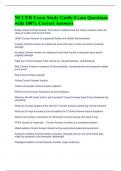the need for communication systems in multicellular organisms. To include the need for animals and
plants to respond to changes in the internal and external environment and to coordinate the activities of
different organs.
Cell activity is regulated by enzymes which can only work under certain conditions, e.g:
a suitable temp & pH
freedom from toxins & excess inhibitors
an aqueous medium for substrates
Cells ensure to maintain these conditions via communication systems.
Living things respond to changes in their environment. Environmental change = stimuli, organism changing
behaviour/physiology to balance the change = response.
Changing external environments
Environments external to the organism consist of air, water or soil.
External environments can change suddenly, e.g. transitioning from a dark burrow into direct sunlight,
or a predator suddenly approaching.
They can also change gradually as seasons pass, eliciting a gradual response, for example foxes
thickening coats in winter.
Changing internal environments
Often, cells inside organisms are bathed in tissue fluid – this is the internal environment.
Some of the products that cells make from substrates are toxic and movie into the tissue fluid – cells’
activities can alter their own environment. For example, if the waste product CO 2 builds up in tissue
fluid (stimulus), it alters the pH and disrupts proteins & enzymes. The organism will respond by
increasing breathing activity to remove this excess CO 2.
The internal environment of tissue fluid is maintained by the blood. Toxins in tissue fluid are likely to
enter back into the blood and be carried away for excretion.
the communication between cells by cell signalling. To include signalling between adjacent cells and
signalling between distant cells.
Cell signalling: the way in which cells communicate with each other.
Cell signalling occurs when a cell releases a chemical/molecule which is detected by another cell. The shape of
the signalling molecule is complementary to the shape of the receptor molecule.
The two main communication systems are:
1. neuronal system (signals between adjacent cells): interconnected network of neurones signal to each
other across synapse junctions. The response is rapid but short-term.
2. hormonal system (signals between distant cells): cells in an endocrine organ release a hormone, the
‘signal’, directly into the blood. The hormone is transported throughout the body but is only
recognised by target cells. The response is gradual but long-term.
the principles of homeostasis. To include the differences between receptors and effectors, and the
differences between negative feedback and positive feedback.
Homeostasis: maintaining a constant internal environment despite changes in external and internal factors.
The standard homeostasis response is: Aspects of homeostasis may include:
stimulus temp
blood glucose conc/salt conc
blood pressure
blood water potential
CO2 conc





